#postcards from ireland
Text
Loving Living Local Celtic Woman Postcards From Ireland Sweepstakes - Win Two Tickets
Loving Living Local Celtic Woman Postcards From Ireland Sweepstakes – Win Two Tickets
Entering into the Loving Living Local Celtic Woman Postcards From Ireland Sweepstakes and chance to win two tickets. So, all United States residents enter the Sweepstakes before May 26th, 2022 to fix your chances to win.
Sweepstakes Entry Page
Sweepstakes Rules
How To Enter :
No purchase is necessary to enter in this Sweepstakes And obtain the prizes.
Open the Sweepstakes page which exists in…

View On WordPress
#Chance to Win Two Tickets#fox21news.com#KXRM Sweepstakes#Loving Living Local Celtic Woman Postcards From Ireland Sweepstakes
0 notes
Text
During the Troubles, Civil Rights Leaders went to Ireland to learn about the plight of the Irish people and to support their fight against colonialism.
Standing on the success of their nonviolent principles which led to civil liberties here (to whatever degree the CRM was successful) and in their ignorance of the history of Ireland, they tried to get the IRA to adopt nonviolent, peaceful civil disobedience.
At the end of their tour of Belfast, where they learned the history and politics of Irish resistance, all of them come to the conclusion that here violence is necessary. The Irish have exhausted all other means including nonviolent ones. Even if some of the CRM leaders maintained nonviolence as paramount, they understood that certain exceptions must be made because — regardless of if they approve of violence or not — their job is to support colonized people and follow their lead.
There is a lesson here that we should apply to the Palestinian struggle.
I’ve seen people pearl clutch over seeing so many dead Palestinians as part of the colonial violence of the camera. This misses the point of why those images are being shared.
Last decade many Black americans, myself included, talked about the commodification of Black death. videos of state murder plastered on every news channel 24/7, going viral across social media platforms connected to the legacy of lynching postcards and gator bait. We demonstrated that those videos rarely got an indictment and only once a conviction. Many of the families of these victims of police murder made it clear they don’t want the image of their loved one to be of death. The reason why we share Michael Brown’s graduation photo instead of the photo of his corpse is because Lesley McSpadden demanded it. With all this in mind, we understand that in most cases the sharing of those images are antiblack.
The Palestinians do not have that history. The Nakba never happened, despite israelis calling this the second Nakba. genocide joe said 40 israeli babies were beheaded after it was found out that the story was some wingnut footsoldier’s lie, not even official israeli hasbara. It was like 2 weeks ago that genocide joe said the number of murdered Palestinians (at the time around 5,000 Palestinians were martyred — the number is now over 10,000) was a Hamas lie.
Linguistically there is no murdered Palestinian. All the headlines read “x amount of israelis killed and some palestinians died”. visually there is no dead Palestinian. official israeli hasbara is trying to flood social media with videos of patient-actors getting into place in Indonesian medical training programs to “debunk” the countless videos of martyred Palestinians.
The denial of the scale of israel’s genocide of the Palestinians is so bad that reporters in Gaza are holding dead children in front of press cameras because Palestinians do not die and are not murdered.
The profit motive of these images is actually in their absence. not their over saturation like with Black americans. The west needs israel as a destabilizing force in the middle east. The strategy of the western media then is to bury these images, to not give them a second of attention. So logically the Palestinian strategy is to proliferate these images to show just how horrifying israel’s crimes are.
Two things can be true at the same time; what works for you doesn’t necessarily work for me etc.
The other thing i’m seeing are liberal frameworks to understand genocide. Of particular ire is desirability politics. *jujubee voice* just say white supremacy.
Desirability is tertiary at best. israel is genociding Palestinians because they want control over Gaza and the West Bank (and Lebanon too). They are not genociding Palestinians because Palestinians are “undesirable.” They make Palestinians undesirable to justify taking their land. Talking about this psychoanalytic bullshit distracts from the primary reason for the displacement and mass murder of Palestinians: the taking of their land.
~*desirability*~ is just one way that israel tries to justify its crimes. Desirability is a circular logic that can only make sense once you manufacture its premise irl. It means nothing without the material conditions it claims are true. Its super easy to call someone an animal after you put them in a cage. It’s super easy to call a people dirty savages after you restrict their access to water. It’s super easy to call someone violent after you sequester them in small, barely livable spaces and stress them with bombings and check points.
It’s also — there’s a way in which opposition to something reifies the very thing that you oppose. Toni Morrison continues to beat everybody’s ass. What does it do when you see a baby with half a skull and say “this happened because she is undesirable”? Undesirable to whom? Not me.
Palestinians are not so passive as to oppose white supremacy and desirability. The Palestinian people are a proactive people. Palestine is the issue. Palestine has a people. Palestine has an ecology. Palestine has life. Palestine is life. Palestinians fight for life. life can neither exist nor blossom under white supremacy.
Any analysis that does not begin with this is a distraction. And distractions only benefit the colonizers.
438 notes
·
View notes
Text
Hozier and romanticizing Ireland, or why the “bog man” shtick should be dropped back into the bog from whence it came
So after a slapdash, frustrated post about the politics of Hozier's music went batshit yesterday, I wanna do a quick follow up about the whole bog man thing, which multiple people mentioned in the reblogs and tags.
Artists are usually known by their names, either the one they got at birth or the one they picked for their career. Beyoncé Knowles Carter goes by Beyoncé, Stefani Germanotta goes by Lady Gaga, Taylor Swift goes by Taylor Swift, etc.
Andrew Hozier-Byrne goes by the stage name Hozier. When talking about him online, most people just call him Hozier, or sometimes Andrew for emphasis or to be silly. Then you have the people who call him stuff like this:








Yeahhhhhhhh, that's just some of what I found in like a 5 minute search. If you search tumblr for "bog man" or "forest daddy" it's almost all posts about Hozier; there's a lot more (and weirder) if you go look on TikTok.
People from other countries romanticizing Ireland isn't new, but that doesn't make it acceptable. Ireland is very much a modern country with modern problems, despite media (mostly American) which prefers to focus on Ireland as an exotic, idealized land, a postcard from the past where everyone lives in cottages and dresses in green and only speaks in mysterious rhyming couplets. Heck, only 3 in 10 Irish people live in rural areas. The other 7 in 10 live in urban or suburban areas, including Hozier. He lives in County Wicklow, which is quite close to Dublin, a city of over 500,000 people and also Ireland's capital.
Like, I'm not saying anyone is The Devil for making a couple "bog man" cracks. God knows I made a few of them back in 2019; one of my old posts makes me cringe because I joked about Hozier and fairy mounds. And you can find old examples of Hozier humoring the gag here and there, whether because he found it funny at the time or because he was just playing along.
Lately, though? When the bogfather/fae king stuff comes up in interviews, Hozier seems uncomfortable with it, even though he stays polite:

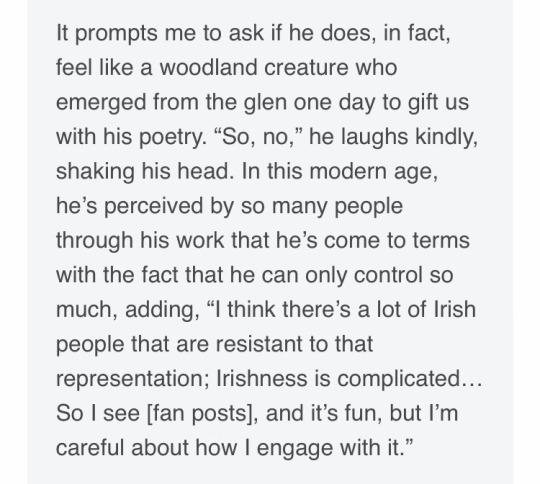
Like. Hozier is just a guy. A dude named Andrew who sings and plays guitar and writes songs and is a fallible human being. Artists can't completely control their image, but if you're a fan of someone's music, you should try to treat them as a person, not a mythical creature or a bundle of stereotypes about their country or a flawless statue to be stuck up on a pedestal.
All of us (including me!) fuck up sometimes. But once we know better, we should choose to do better.
#hozier#andrew hozier byrne#unreal unearth#bog man#forest daddy#I did NOT expect my prior post to blow up#rip my notifications
241 notes
·
View notes
Text
'...Social media has played into this Irish invasion, with users fangirling over actors like Paul Mescal, Barry Keoghan, Andrew Scott, and Cillian Murphy. All of these men have been recognized for their work in critically acclaimed and/or popular films in 2023. Cillian Murphy is nominated for (and forecast to win) an Oscar for his role in Oppenheimer.
...this new male-driven phenomenon likely stems from the convergence of the two online trends: an overwhelming fan appetite for male celebrities in the “internet boyfriend” era, and a growing interest in Irish culture. The result is a super-online (and horny) generation of Hibernophiles.
...the modern romanticization of Irish men doesn’t seem to be pegged to one film or moment in time, and a cursory Google search pulls up a slew of articles declaring the purported pros of dating Irish men. These lists are not necessarily based on hard facts as much as cultural assumptions, and many of them, including one by Popsugar, emphasize the Irish’s supposed charm, good looks, chattiness, and love for their mothers...
Presumably, there’s a link between the idyllic postcard image many Americans have of Ireland — lush green pastures, poetry, music, and a friendly population — and the view of Irish men as ideal romantic partners. It has certainly helped that Americans and consumers worldwide have been inundated with images of handsome Irish men in popular culture, from former James Bond star Pierce Brosnan to One Direction member Niall Horan to scruffy sex symbol Colin Farrell. While interviewing Cillian Murphy on his podcast Armchair Expert in 2022, host Dax Sheppard raved about the “inordinate amount of handsome men” he encountered on a trip to Ireland...
The 1845 Irish famine meant a huge influx of immigrants to the US, and the men quickly gained a reputation as “feckless, uncultured, and prone to drunkenness and violence,” Burke explained. “That stereotype has been argued to have persisted to some degree right up to the era of John F. Kennedy.” Kennedy’s election, she says, was thought to signal the full assimilation of the Irish in America. (A shift that, in turn, brought us notable Irish Americans like Alec Baldwin, Sean Hannity, and Bill O’Reilly.)
This shift in perception represents the “flexible racial status of Irishness,” as Diane Negra, film studies professor at the University College Dublin, writes in the book The Irish in Us: Irishness, Performativity and Pop Culture. She expands that this is due to a complex history and ethnic identity that allows them to “oscillate between otherness and whiteness.” Likewise, Burke says white Irish people fit into a category of “non-vanilla vanilla” in the Western imagination.
For the American viewer, “Irish actors arguably evoke a kind of safe ‘exoticness,’” she said. “Being native speakers of English with a purportedly cute accent, they are just ‘foreign’ enough for mainstream taste.”
That newfound perception of Irish men as harmless and gentle feels connected to a wider trend that they’ve shown up in on the internet: the “babygirl.” The moniker has become a go-to term of endearment for grown men in Hollywood who are physically attractive and display pleasant traits. According to Mashable, it describes “when a man is being cute, comfortable in his masculinity, or weak in an evocative way.” This act of infantilization can be applied to a wide range of men, but it’s hard not to notice actors like Mescal, Keoghan, Murphy, and Farrell being popular recipients of this treatment online...
The Andrew Haigh film All of Us Strangers, starring Andrew Scott and Mescal, was on the precipice of Oscars glory, with Scott campaigning but failing to make it to the final stage for Best Actor. For months throughout awards season, though, Mescal and Scott were making the internet swoon in joint interviews and red-carpet appearances, demonstrating that their onscreen chemistry carried over into real life. The same attention was paid to Keoghan, who became more of a talking point throughout awards season for his role in the polarizing Emerald Fennell film Saltburn — not to mention that nude dance scene — than a realistic Oscars contender.
Last but not least, there’s Cillian Murphy, whose role in Christopher Nolan’s Oppenheimer could very well win him an Oscar on March 10, after a near-sweep at the year’s major awards ceremonies. The standom and thirst for him on social media is particularly striking, given that he’s had a lengthy, mostly unsung career that hadn’t yielded huge starmaking moments before Oppenheimer, despite playing multiple side characters in Nolan’s filmography. Prior to playing the “father of the atomic bomb” last year, his most notable role as a leading man was as gangster Thomas Shelby in the BBC2 show Peaky Blinders, which ran for almost a decade and earned a strong Tumblr fan base.
Professor and author Christopher Shannon adds that the public’s affinity for Murphy is particularly fascinating, given that American audiences haven’t necessarily fallen in love with him through Irish cinema like previous Irish actors.
“What strikes me about someone like Murphy is that he has achieved his fame mostly in non-Irish roles,” he said. “Murphy is celebrated as an actor who happens to be Irish rather than as a distinctly Irish actor.”
Nevertheless, Murphy’s Irish identity seems to be part of his draw, based on how his online fan base interacts with him. Despite being rather reserved, the Batman Begins star has generated an entire mill of memes, many of them stemming from routinely unenthused interactions and a general “who gives a fuck?” attitude. In particular, it seems as though the internet enjoys the ways he firmly declares his Irishness.
One of his most viral moments is a clip of him repeatedly stating that he’s Irish after an interviewer refers to him and his Inception co-star Tom Hardy as British. Another popular image of Murphy shows the actor seemingly giving Prince Harry a dissenting glare as the cast lines up to meet him at the Dunkirk premiere. This could well just be Murphy’s natural expression (he’s not exactly known for looking cheery), but the internet interpreted Murphy’s look as proof of his disdain for the British monarchy...
Murphy has said that it’s a “good time to be an Irish actor” in Hollywood. At the same time, when asked how he felt about being the first Irish-born actor to win Best Actor at the BAFTAs last week, he seemed slightly exhausted by a sense of tokenism. “It means a lot to me to be Irish,” he answered a journalist. “I don’t know what else to say. Should I sing a rebel song?”
Of course, this quip only made the Murphy Hive fall in love with him more.'
#Cillian Murphy#Barry Keoghan#Andrew Scott#Paul Mescal#Aftersun#All of Us Strangers#Oppenheimer#Saltburn#Oscars#BAFTAs#Pierce Brosnan#Niall Horan#Colin Farrell#Christopher Nolan#Tommy Shelby#Peaky Blinders
28 notes
·
View notes
Note
What do you like about Voldemort/Tom Riddle as a character? What elements of the character do you find fascinating?
thank you so much for this ask, @sarafina-sincerity
i have received a flurry of asks about my main boy, lord voldemort, which form a neat triad, so this is part one of a three part meta on him:
1. what do i like about voldemort as a character?
2. what is my preferred way of writing voldemort (a character analysis deep-dive)? [here]
3. what does dumbledore get wrong about voldemort? [here]

what do i like about voldemort as a character?
my general principle as a reader, both in fanfiction and original fiction, is that villains are more interesting than heroes. i prefer the complexity of characters the audience is not supposed to root for, and i enjoy the confrontation of realising that people who are capable of astonishing brutality and evil are also simultaneously capable of beauty. indeed, one of the most heart-breaking passages in literature, in my opinion, is humbert humbert’s final encounter with lolita, in which the reader is forced to sit with the fact that a violent, sadistic, and dangerous paedophile is also a creature hollowed by grief and loss, and that they feel nauseatingly sorry for him.
the canonical voldemort’s complexity in these aspects isn’t entirely drawn out in the narrative - although voldemort’s own struggle with anger, grief, and loss is discussed in details in the third part of this series of meta - but thinking of him in these terms provides something that i think is of considerable value to me as an author.
as might be hinted by the nabokov, my favourite subgenre of original fiction is undoubtedly the american literature of the mid-twentieth century, for its portrayal of the sinister ennui which lurks under the quaint picture-postcard of the american dream life (that i like voldemort for what he reveals about the rot in the wizarding world is expanded upon below). the authors i have felt speak most profoundly to this apart from nabokov are shirley jackson and - and i recommend this enormously not as pulp fiction but as a sincerely raw look at the america of the 1940s and 1950s - jacqueline susann’s valley of the dolls. voldemort has a lot in common with jackson and susann’s famous anti-heroines: he has the jealous, isolated relationship with family and lineage of merricat blackwood and the childhood trauma leading to obsession, manipulation, and greed of neely o’hara.
all of which is to say, he is a character whose complexity can be used to challenge the reader, to force them to have to sit uncomfortably with their own views and biases (the fact that he’s a self-hating sectarian terrorist has always hit me like a body-blow, given that i live in northern ireland…), and to provide a window into the broader commentary on the world of the story (and the world of the author).
voldemort as a narrative tool
indeed, voldemort is the character who most interestingly straddles the harry potter series’ various different genres and their subtypes - no mean feat, given that the difficulty of reconciling these separate genres is what drives many fans’ complaints about plot-holes in the series.
after all, the series literally wouldn’t function as children’s literature without him; in the first two books he provides that scooby-doo villain-turns-up-in-disguise-at-the-end flavour which drives the narrative and allows harry to conform to his own children’s lit archetype of the wise-cracking everyman hero who is constantly getting into wacky mysteries.
but voldemort is, of course, at his most interesting after the books undergo their tonal shift following the conclusion of prisoner of azkaban:
he is the series’ most significant and most complex character within the genre-types it borrows from noir and political thrillers - in goblet of fire, we get the hint of him as a paramilitary kingpin, whose supporters wished to incite terror into any members of the wizarding population who did not support blood-supremacy and who targeted state institutions and political figureheads who stood in their way. voldemort’s own hypocrisy - he is a supposed pureblood champion despite not being pureblood himself, although his anti-muggle views are undoubtedly sincere - serves as a concentrated metaphor for the ministry’s corruption, which harry uncovers throughout this book.
he is the series’ most interesting folkloric archetype - the fate-driven hunter-villain, whose belief in the mystical value of the prophecy (within a series in which all the other characters - except harry, who we’ll come to below - are surprisingly rational. for people who can do magic.) drives the series towards its conclusion. it is impossible for harry to go on his hero’s journey without voldemort, and given that many of the other characters fit more obliquely into their folkloric archetypes (ron is very different from many folkloric sidekicks - the boy is no samwise gamgee - and hermione’s folkloric archetype is closest to the non-human gift given to the hero by a donor-figure), this aspect of the narrative depends on voldemort entirely.
he is, perhaps, one of the less interesting characters within the series’ purpose as christian allegory (the award for the character this applies to most interestingly, for me at least, is either dumbledore - the word of god revealed in a twist to be the john the baptist - or snape - the paul who thinks he’s a judas), since he is the satan allegory. the catholic-coded nature of many of his behaviours, however, does fascinate me, and contribute to my headcanon - discussed in the next meta - that he is raised in a church orphanage.
and the use of voldemort within these narrative confines changes many of the other characters in ways which move them beyond genre archetypes which might otherwise not allow them to grow as the narrative tonally shifts (a fate which befalls hagrid, who cannot stand up to the nuancing of harry’s character as he goes on his hero’s journey). dumbledore’s similarities to voldemort, for example, hint at the reversal of his omniscience and infallibility before deathly hallows hits; snape’s relationship with voldemort as a terrorist leader, and particularly what voldemort’s terror says about the social structure of the wizarding world, provides an explanation for his actions which is more complex than ‘tee hee mudblood’ and which gives the reader a space to think about how deprivation drives radicalisation in our own communities.
above all, voldemort’s narrative relationship with harry is fascinating - and not simply for shipping reasons - since, within a story which ends with harry in the guise of the resurrected christ and voldemort-as-satan dead and buried, they are never actually portrayed as black-and-white enemies. indeed, they are the only pair of narrative mirrors in the series whose relationship is portrayed not as diametric, but relational; the only two whose relationship is described as fraternal (something made explicit in their ‘brother’ wand cores); and the only two whose relationship is described - by a figure no less powerful than the prophecy itself - as equal.
for example, that their shared backgrounds, their views of their own orphanhood, their relationship with their fathers, and their physical appearances are similar is lampshaded by several characters - not least both of them themselves. but the narrative actually goes deeper, drawing out ways in which their differences appear stark, but then loop back to become another similarity they share: their mothers come from opposing blood classes, but both form the key to understanding their characters; their wand woods are both associated with death and resurrection, albeit with different folkloric values of luck and purity attached to them; and voldemort is the series’ ‘true slytherin’ and harry the series’ ‘true gryffindor’, but they both have numerous personality traits connected to the other house.
in contrast, if we take the narrative mirrors of ron and draco malfoy, we find a pairing whose differences stem from similar attitudes and insecurities, but manifest themselves in ways which are polar: both serve the crucial narrative purpose of explaining the wizarding world to harry and, therefore, the reader, but ron exclusively shows its positive aspects and malfoy its more negative ones; their material circumstances are opposites; they both heavily physically resemble the rest of the family, but ron is one of many siblings and strains against that and malfoy is an only child and strains against that; and they are defined in the text by the diametrically opposed nature of their relationship with harry.
harry and voldemort, on the other hand, are defined by the divergence of their similarities - like their wands, they have the same core, but their choices affect them profoundly - and they are, therefore, the series’ clearest examples of the value of choice.
voldemort as a social mirror
i also think that voldemort’s childhood and background is one of the series’ most interesting looks at britain and its social dynamics, which i think many readers miss. how i prefer to write voldemort’s childhood is discussed in the second part of this series of meta, but he provides - like hermione - a look at the profound irony of the class system (after all he is an aristocrat in both worlds - and an example of both types of aristocrat, the rich and snooty in their luxury manor and the impoverished clinging to a name and a lineage - who has no access to the social advantages this should bring because he was born in an orphanage in the muggle world and he has a muggle name and face in the wizarding one).
but, above all, voldemort spends the first six books of the series as the best cipher for how state brutality and corruption only begets more violence. his unusual tolerance of non-human magical creatures (and his openness in his brutality to slaves - which, as i have argued, is one of the things that shocks regulus, who clearly conceives of himself as a ‘good’ slave-owner, a thing which does not exist) is at odds with the ministry’s benign oppression. his rejection of the patronage networks which sustain wizarding society (he rejects slughorn’s offer to set him up in the ministry because he wants a job he got himself, and good for him) only serves to emphasise that these still exist (the fact that voldemort would not want to rely on patronage canonically never occurs to dumbledore); while his use of patronage networks for his own ends shows how easily structures considered to be ‘right’ or ‘normal’ can turn malign. his brilliance, but the fact that his name and background would clearly constrain him in an ordinary career, underlines the fate which befalls many characters, from snape to the weasleys. he has a complex relationship with gender in a series which otherwise doesn’t (not only in the fact - outlined in the second meta - that his own gender identity is incredibly interesting, but in that bellatrix is the only married woman in the seven-book canon who has both a speaking part and a job). the ministry’s reaction to him - particularly the suspension of due process in the trials of death eaters (a reference to operation demetrius, one of the british government’s most degrading extra-judicial decisions during the troubles) - deepens anti-government resentment, which - since the wizarding world is clearly not a democracy - has nowhere else to go but revolution.
voldemort causes himself, obviously, but the ministry enables him to exist, and this provides so many avenues in fanfiction to explore.
why we need fanon voldemort
this said, there are, of course, things which frustrate me about the canonical voldemort - and this drives many of the traits in my own writing of him which i am completely aware do deviate from canon (my preferred characterisation of voldemort is addressed in the second part of this series of meta).
i dislike the portrayal of the canonical voldemort - or, at least, the canonical adult voldemort, the canonical teenage voldemort is more layered - as a sociopath, largely because i think it’s quite lazy writing to have a villain whose evil is caused by just not getting human emotion. in particular, this absolves the reader from noticing our own similarities to voldemort and considering how that challenges our own views and biases - as the enormous amount of ‘the class system is good, actually’ in death-eater-centric writing shows.
above all, i loathe the argument that voldemort can’t feel love (i am hopelessly wedded to the idea that he does love bellatrix, in his own little way), not least because it is an extremely cruel interpretation of what is clearly enormous childhood trauma (although the series’ weaknesses in its approach to that topic go far beyond voldemort), and because it fails to open space for a critical look at dumbledore’s own idea of love; that is, not as something which can be luxurious, pampering, and restorative to the self, but as something which depends on sorrow and sacrifice. i detest the fanon - which, i think it’s important to note, is based in something jkr never actually said - that voldemort’s conception is the cause of his attitude to love. i also think the way the text treats both tom riddle sr. - who is never acknowledged as a rape victim - and merope - who, if we take dumbledore’s implication that she could have survived voldemort’s birth at face value, directly justifies voldemort’s view on death by not bothering to stay alive for him - is horrifying.
i think the voldemort of deathly hallows is the weakest, not least because the fact that he is never shown in the previous six books to have an interest in running a government (he spends most of the early books as a paramilitary leader, not a dictator in waiting) means that he has to be shunted off in other directions when he takes control of one.
and, with the greatest of respect to the wonderful ralph fiennes, who i’ve just paid a huge amount of money to go see in macbeth, the film version of voldemort is terrible. indeed, film!voldemort is the source of so many of the worst fanon readings of the character, especially the idea that he only knows one spell, that he’s insane (the statement of canon is that the creation of the horcruxes does nothing to damage his mental capacity, since the soul exists independently of our free will and rational thought - although clearly the voldemort of the second war becomes considerably more paranoid than his earlier incarnation), that he loves to shriek, that he isn’t very scary, and that he doesn’t come spectacularly close to winning.
up next, then, how do i like to write voldemort?
64 notes
·
View notes
Text
Idk outsiders ethnicity headcanons !!
Darry
- all four grandparents are Irish immigrants!
- it doesn’t affect him at all, he does not care
- all he knows is St. Patrick’s day, he goes overboard with the pinching and the green
- they’re Protestant, and while he isn’t really religious, it still had an effect ofc
Sodapop
- also Irish (obviously)
- he always goes crazy for holidays, so everyone makes sure to wear green on St. Patrick’s day. It’s all he knows about Ireland lmao
Ponyboy
- Irish (again)
- the only one that actually knows anything about Ireland.
- he likes to look at postcards and pictures of it. He thinks it’s very beautiful. He kind of wants to move there someday
- church had an effect on him too (that’s canon though)
Two-Bit
- he’s welsh, his moms parents still live there (he’s never met them)
- his mom still has a slight accent, he teases her about it
- he used to have an accent when he was a baby lol
- his dad was also welsh, but he left so Two doesn’t gaf about him and his side
Steve
- his dad has distant Scottish ancestry, but neither of them know anything about Scotland so they don’t care.
- his mom was Apsaalooke, and she was from Montana. Steve doesn’t know because she died when he was a baby and it hurts his dad to talk about her
- Steve has also never seen a picture of her before either. He has no idea, his dad doesn’t realize that he has no idea
Johnny
- both parents are Shawnee
- they moved away from their families because their families didn’t want them together. Part of the reason they’re still together is because they fought so hard to be together that they don’t want to separate now that they hate eachother
Dallas
- he doesn’t know anything about his heritage because he never sees his dad and his mom is dead
- but he’s polish
- his dads surname was “Witowski” but he changed it to Winston because ppl kept thinking it was Russian and harassing him
- so his dad hates Americans because of it
Tim
- mom is a Russian immigrant, dad is a Spanish immigrant. He doesn’t know anything about either cultures
- mom moved to America in the 30’s with her brother and met his dad almost immediately.
- then they moved to Tulsa! Also tim hates his uncle lol
Angela
- same as Tim, but she gets along with her uncle and actively enjoys Russian culture
- she was only three when her dad died so she also doesn’t know anything about Spain or her dads side
Curly
- he has a different dad (one of my fave hcs) and his dad is also Russian, so he’s fully Russian
- also loves their uncle and enjoys Russian culture
Bryon
- British ancestors
- he does not care about his heritage, he has more important things on his mind
- also it’s such distant ancestry that it rlly doesn’t matter
Mark
- so I hc dallys dad to be the infamous whore cowboy that fathered mark and Tex, so he’s half Russian
-his mom is Shawnee though (was ig, since she’s dead)
- he is aware, but he doesn’t like to think about his family for obvious reasons, he likes to think taht he’s just bryons brother
Cathy
- I also hc her and M&M to be two-bits cousins! Their dad is his moms brother (solely based on the fact that they all have grey eyes)
- so she’s welsh. She sends letters to her grandparents but has also never met them
M&M
- also welsh ofc
- his dad forces him and Cathy to send letters to their grandparents. His grandparents do not like him so he hates it
- he does think Wales is very cool though
#darry curtis#sodapop curtis#ponyboy curtis#two bit mathews#steve randle#johnny cade#dallas winston#tim shepard#angela shepard#curly shepard#bryon douglas#mark jennings#Cathy Carlson#m&m carlson#the outsiders#that was then this is now#the outsiders headcanons#darry curtis headcanons#sodapop curtis headcanons#Ponyboy curtis headcanons#two bit Mathews headcanons#Steve randle headcanons#dallas winston headcanons#johnny cade headcanons#tim Shepard headcanons#Angela Shepard headcanons#curly Shepard headcanons
32 notes
·
View notes
Text

@gravy-slut sent me a postcard from Ireland!! 🇮🇪 🍀
5 notes
·
View notes
Text
Semi 1 thoughts
Loved the celebration of past ESC editions, as always. Did not expect Dustin the Turkey to show up, he looks as fresh as ever
I was doing the "DiCaprio pointing at TV" meme every time they've shown Kyiv in the postcards
The postcard concept is really cool, btw
The sound was weird in the first half of the show (Luke sounded like he was singing from a metal bucket). I thought that something was wrong with my TV, but apparently, it was a broadcast issue
the fact that Let 3 were allowed to bring the missiles is just 🤌
Sudden Lights now join the ever-growing collection of my beloved non-qualifiers :c
I've managed to warm up to Ireland somehow. guess the sparkles have melted my cold heart
fuck you, Switzerland, once again, wish everyone else qualified instead of Remo
very happy for Mimicat, she totally deserved it
my boyfriend's favorite of the night was Azerbaijan of all things. he liked the rap and then started nerding out about their guitars
Käärijä slayed as expected, the shot of him bursting out from the top of the box is hilarious
i was going to complain about how announcing Norway last was anticlimactic, but then realized that I'm getting bonus Fantaeurovision points for this
18 notes
·
View notes
Text
The Brotherhood of the Travelling Warlords
Thank you everyone who helped send me armchair travelling around the world (and in some cases, into the past as well). It was a lot of fun to research these places and try to figure out what our warlords would want to check out while they were visiting.
Event summary...
Fifteen postcards written, as requested by fourteen people.
Warlords on the move: Mitsuhide (4), Nobunaga (2), Shingen (2), and Masamune (2) win the frequent flier honors, but Sasuke, Yukimura, Keiji, Mitsunari, and Kennyo also got to do some sightseeing as well.
Of all the places requested, I had been to three: Times Square, Washington DC, and Dublin Ireland. I've been to Chicago before, but not during the 1896 World's Fair.
Warlord who gave me travel-envy. I've always wanted to go to Hawaii, New Orleans and Prague, so I would have stowed away in Mitsuhide's suitcase without question.
Places I learned about that I now want to visit: Vigan City and Hoi An Ancient Town.
Place that was a nope... well, we sent Sasuke to an active volcano...
Request that gave me the most difficulty. Rome in 2020, only because I had to do some research to figure out what the COVID restrictions were at that time.
Favorite finished postcard design. I really liked the way Paris France, 1900 turned out. The artwork and graphic design of the era is so very much in my aesthetic sweet spot.
Easter eggs... all of Mitsuhide's postcards have a faint hidden graphic underneath the text of the postcard.
Favorite postcard text - I think I might go with Mitsunari on this one. I figured of all warlords, he'd be the one who started out writing his postcard too big, and be forced to make the lettering get smaller and smaller until he had to write up the side of the card (also he was writing the postcard while on a tour bus for part of the time, so it was a little messy for that reason too). Plus, I just enjoyed thinking of him trapped in Trinity College library and not worried at all about it. Him losing his shoes was a running joke in his longfic, so I stuck that in there too.
Mistakes... I think my biggest planning mistake was not figuring out in advance a couple of the world building issues. Would these warlords be going to a recipient who was currently living in Azuchi (or Kasugayama)? Since some of the requests were anon, or from posters I don't know very well, I made the assumption that the postcard recipient had indeed been previously wormholed into the Sengoku. Also, how would the warlords deal with a language barrier? With that one, I figured that for any warlord travelling to a timeline past (or just around) the 20th century - they could probably find someone who spoke their language (both Kennyo and Masamune went to World's Fairs where there was a Japanese installation). But when Shingen went to Ancient Greece and Mitsuhide went to the Golden Age of India, I figured they would just have to do their best with pointing and making up a sign language as they went along (they're both smart men, they can adapt!). Masamune had less difficulty in medieval Poland, not because he found someone to translate, but because he travelled into a siege situation and I figured he was well enough acquainted with battles that he'd do ok ... I er, quite possibly overthought these.
Along those lines... while I had fun picking out handwriting fonts for the warlords, I made a few mistakes early on... Mitsuhide's for example, took up too much space and I couldn't fit as much content on his cards (and so of course, he was the most requested warlord).
Curious about the handwriting I picked? I was pretty random about it... mostly it was a combination of what felt right to me, plus whether or not it would fit on the postcard. Shingen is more romantic, so his handwriting is flowy, whereas Nobunaga's takes up a lot of space - but I had to balance an authoritative font with being able to include a decent amount of text. I figured that Mitsuhide would think faster than he writes, so his is a little more careless looking, and Sasuke would print, because he's used to writing lab reports. And of course, once I picked a handwriting font for one postcard, I kept it through the rest of them.
Here is everyone in a row, for comparison:

As for the postcards themselves... here they are gathered once more...
Masamune visits Malbork, Poland in 1460
Mitsuhide visits Maui, Hawaii
Keiji visits Times Square, New York, New York
Sasuke visits Koma-ga-take volcano in 1582
Shingen visits Ancient Greece
Yukimura visits Rome, Italy in 2020
Mitsunari visits Dublin, Ireland
Kennyo visits Paris, France, 1900
Mitsuhide visits Pataliputra, India, 300 to 600 CE
Mitsuhide visits New Orleans
Nobunaga visits Washington, DC
Nobunaga visits Vigan City, Philippines
Masamune visits the World's Fair, Chicago, 1893
Shingen visits Hoi An Ancient Town
Mitsuhide visits Prague, Czech Republic
Thank you again to everyone who requested a card. Maybe some day I'll bring this back!
#200 followers#event summary#ikemen sengoku#asks#answered#the brotherhood of the travelling warlords#ikesen mitsuhide#ikesen nobunaga#ikesen masamune#ikesen mitsunari#ikesen keiji#ikesen kennyo#ikesen shingen#ikesen yukimura#ikesen sasuke
26 notes
·
View notes
Text
A supernatural Saint Patrick

Here's a health to St. Pat!, early 20th century. John I. Monroe collection of general postcards
Among the dozens of Saint Patrick's Day postcards in the Newberry's digital collections, you'll find any number of shamrocks, bagpipes, and Irish jig dancers. One thing you won't see? Leprechauns.
Dating back to medieval times, the traditional leprechaun in Irish folklore worked as a cobbler, wore a brown or red coat, and liked playing tricks on humans. It was only after the popularity of Disney's 1959 film Darby O'Gill and the Little People that the modern leprechaun -- green suit, red hair and beard, still a trickster -- came to be synonymous with the holiday.
Those celebrating Saint Patrick's Day during the golden age of postcards (1905-1915) exchanged greetings via a very different super-powered being: Saint Patrick himself, the 5th-century missionary and patron saint of Ireland. See below for an illustrated tour of his legends/miracles.

St. Patrick freed old Erin..., 1910. John I. Monroe collection of general postcards
True fact: Ireland has no snakes. Not so true fact: That's because Saint Patrick banished them; after being attacked by these devil's minions, he rid Ireland of evil by driving them into the sea.
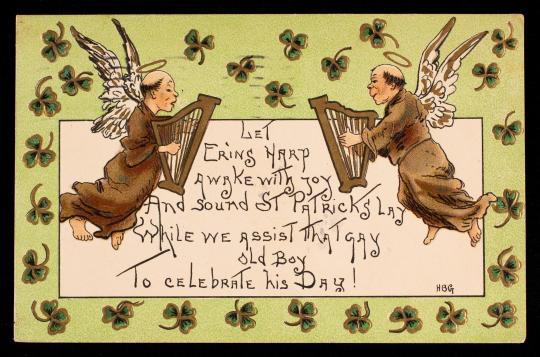
Let Erins harp awake with joy..., early 20th century. John I. Monroe collection of general postcards
Bordering this postcard is a string of shamrocks, Ireland's unofficial national flower. When converting the pagan Irish population to Christianity, Saint Patrick is said to have used the shamrock's three leaves to explain the concept of the Holy Trinity.
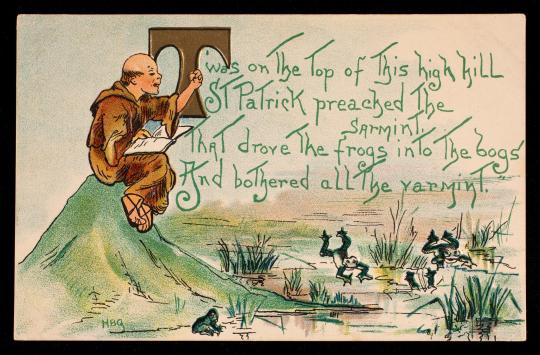
Twas on top of this high hill..., 1910. John I. Monroe collection of general postcards
Much like Moses, Saint Patrick undertook a 40-day fast atop a mountain -- which was then named after him.
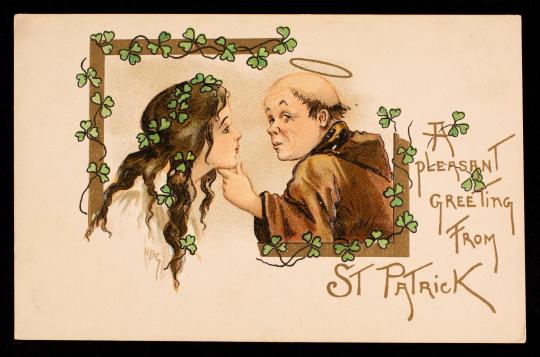
A pleasant greeting from St. Patrick, early 20th century. John I. Monroe collection of general postcards
No particular legend here, and not very pleasant greetings if you ask us -- but Saint Patrick's interactions with women include his exorcism of a demon from a female innkeeper by encouraging her to be less stingy when serving alcohol. Centuries of Saint Patrick's Day binge-drinking ensue. 🍻
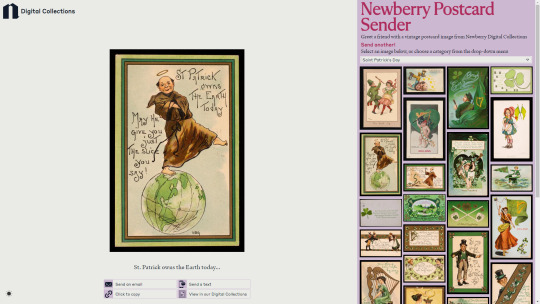
Newberry Postcard Sender
Have you tried out our Postcard Sender yet? Reach out to friends and family with a vintage postcard e-greeting that they'll receive instantly -- no miracles required!!
#newberry library#libraries#special collections#vintage postcards#st. patricks day#collection stories#newberryj
4 notes
·
View notes
Text
hello, 2024
In Ireland, at midnight on NYE it's been a tradition to open your backdoor to let the old energy from the year out + open the front door to let the new fresh energy in. Out with the old, in with the new. As a [recently discovered] Irish gal myself, I'll be participating in this tradition. It reminds me of an even classier version of the Irish exit, which I've been a fan of for many years now. With that being said...
what's in?
20 min sauna sessions per week
Brain games to prevent dementia
Lions mane
Gardening + growing your own herbs
Baking your own bread
Sending physical cards/letters/postcards when you're thinking of someone
Trader Joe's flowers just because
Cold showers
Forgiving people for your own sanity
Water flossing in the shower
Mouth taping
Magnesium on the bottom of your feets
Gratitude journal
Hot girl walking meditations
Redlight mask BEFORE skincare (when will I remember this?)
Drinking 2L of water
Preparing breakfast the night before
Prenatal vitamins, iykyk
Morning + Night routines
Saving for a home
Somatic therapy, keeping track of sensations in the body
Listening to healing hertz frequencies regularly
Drinking water + putting food in your stomach BEFORE coffee
Cottage cheese
Electrolytes + minerals
Journaling
Reading 10 pages per day minimum
Planning meals for the week
Loud budgeting
Mocktails
Nighttime tea
Minimalism
Writing shit down on paper
Remembering important dates - birthdays, anniversaries, death anniversaries, etc.
Celebrating accomplishments for others + making them feel special
Manifesting
Staying home
Validating myself
Tapping when anxious or disassociating
Selling + donating things I don't need
Focusing on my short + long-term goals
Romanticizing the little things
Pilates
Coffee dates
Book clubs
Handwritten notes
Dinner parties at home
what’s out?
Alcohol
Going out
Spending time with people who have bad energy
5 second trends. Learn to care about our planet
Amazon obsessions (I've been guilty of this all year long)
Clutter
Endless scrolling
Instagram
Consuming pork
Food apps
Too many processed foods
HIIT workouts
Limiting beliefs
Restaurants
Using my iphone as an alarm clock
The housing market, housing shortages
Friends not celebrating your accomplishments
Jealous energy
Following people's every move on social media + not liking their content (unfollow me weirdo)
Overconsumption period
Not caring about the planet
Not caring about animals
#new year#2024#new year resolutions#insandouts2024#luxury lifestyle#level up#Spotify
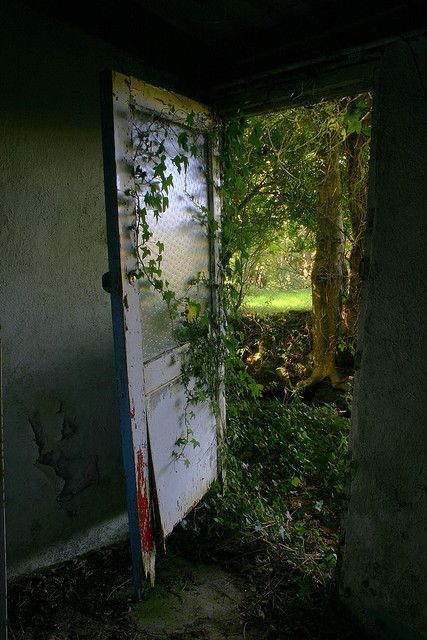
3 notes
·
View notes
Text
Ireland, Summer 1994 - Batsheva Dori-Carlier - Israel
Translator: Lisa Katz (Hebrew)
Through the window of the Aer Lingus plane,
a green fan of fields embroidered with brown furrows.
“The weather is fine in Dublin, no sign of clouds”.
(Did the pilot sound surprised.)
In the arrivals hall of Shannon airport
you wrapped me in your gray raincoat:
“How was the flight?”
You opened the door to the apartment on Drumcondra Street
with a royal sweep of your arm.
We shared yellow butter and whole grain bread,
Leonard Cohen songs and insights we’d gathered
(sanctimonious, unquestioning).
I looked through the kitchen window, charmed
by the red brick wall in the back yard,
half-covered by greenery, an unkempt beard.
In the evening in the pub on Grafton Street,
joy flowed thickly, simply, like foam.
Our coats clung to each other on the polished wooden hanger,
soaking up poetry, pipe smoke and melting steam.
We drank from mugs of thin glass decorated with golden harps:
a pint of black Guinness poured into the evening’s talk.
Your bachelor bed gazed in envy as we slept entwined.
“There are some dead certainties and some lively doubts”
claimed the sign on the church wall.
I copied snide quotes on a postcard to my sister.
In the afternoon we rested on the banks of the Liffey,
fumes from the brewery wafted through the air
like drunken sheep.
Tomorrow we’ll set out for our trip to the Dingle Peninsula,
three days at an inn.
We stood at the edge of an overhang:
clear salt water swirled over purple sea weed
and foamed, rough as a fist, on Ireland’s coarse skin.
We were silent, careful not to be swept away
into the constant quarrel between land and water.
Your old car led us faithfully,
navigating roads covered with the leaves of trees and shrubs.
I was twenty-four and complicated,
Yeats and Maud Gonne on the horizon
through the windshield.
#Ireland Summer 1994#Batsheva Dori-Carlier#Israel#translation: hebrew#poem#poetry#poems from around the world
5 notes
·
View notes
Text
Vintage Postcards!
Our second most voted-on topic in our poll was vintage postcards! These postcards range from 1908-1999 and are in our Postcard Collection (M36). The first four are from Mississippi and the last two are from Ireland and Cuba!
Each postcard has had the transcribing done on all of the cursive handwriting (to the best of our abilities).

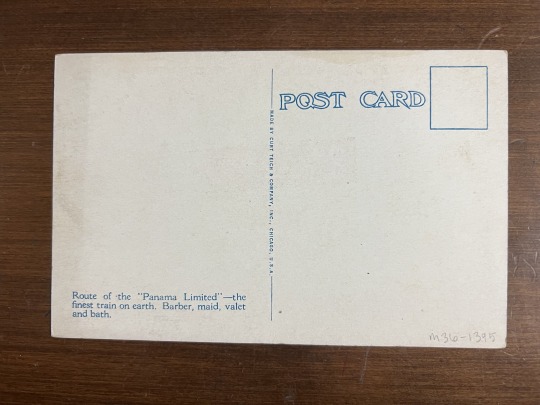




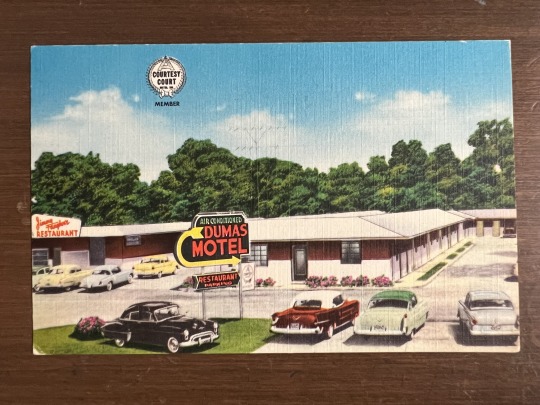


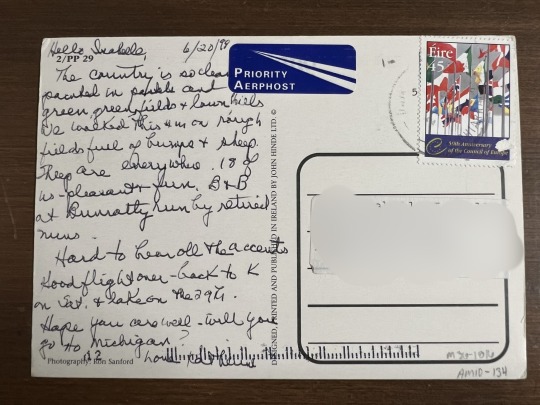


Next week we will post our Civil Rights campaign posters from Mississippi!
#reading cursive can be ROUGH#archives#special collections#library#libraries#books and libraries#vintage#postcards#vintage postcards#travel#mississippi#ireland#cuba#usmspcol
13 notes
·
View notes
Text
Message I sent via White House contact form (I need to follow it up with a written postcard; handwriting still makes a big difference these days)
——————
Mr President, I usually contact my representative and senators (Kamala!) but the Palestinians dying under bombs funded by US taxpayer dollars can't wait. PRESS ISRAEL FOR A CEASEFIRE NOW.
I also condemn Sec. Blinken asking the Qatari gov to muzzle Al Jazeera's news coverage from Gaza. I know fanning Arab anger against Israel and the West spurs terrorism, but SO DO THE ATROCITIES ISRAEL IS COMMITTING.
We cannot be a party to Israel's war on the truth, its attempts to cut off all info from within Gaza, its DDOS attacks, its propaganda to justify its savagery against civilians WHO ARE NOT HAMAS.
This is like the UK had responded to IRA bombings by walling off and bombing all Catholic areas of Northern Ireland. It would only have compounded the grievances causing the Troubles.
I don't make that analogy lightly. I might have been an Israeli, my own family members of the IDF or hostages of Hamas, if my Jewish grandfather hadn't married a gentile and stayed in the US. I'm not Jewish by religion, but I identify it as my heritage. Granddad lost cousins in the Holocaust. I have feared and fought the rise of white supremacists and antisemitism in the US since before they found a figurehead in Trump.
But I also learned from Rabbi Lynn Gottlieb in 1990 of the plight of Palestinians under occupation. Many Jews of conscience have reported how Palestinians have been ghetto-ized and abused with many of the same injustices and atrocities historically leveled against Jews. "We have met the enemy, and he is us." — Pogo
I do not condone Hamas' attack any more than you condoned IRA bombings. But I sympathize with the anger that prompted them. No wonder there were Free Palestine murals and flags in Belfast when I visited.
Please, step back from US Middle East strategy and be the statesman who helped broker the Good Friday Accords.
One can condemn Israel's war on Palestinians without being anti-semitic, as one can condemn Hamas' attack without being anti-muslim. Do so.
————————
[Note:  I am shading this message for President Biden's ears.  I didn't say I have more sympathy for freedom fighters in an occupied territory fighting for their families than I do the state of Israel committing genocide, because I was afraid that would get this message dismissed before it reached Biden's desk. I think my analogy with the IRA will suggest it, due to Biden's Irish Catholic heritage and role as a mediator in that conflict.
I don't know if Biden has continued Obama's practice of reading 2 to 5 interesting, insightful and/or typical messages from constituents, as selected by his staff each day. But if he does, then I'm trying to do what I can to increase the odds my message will be one of those he sees.
4 notes
·
View notes
Text
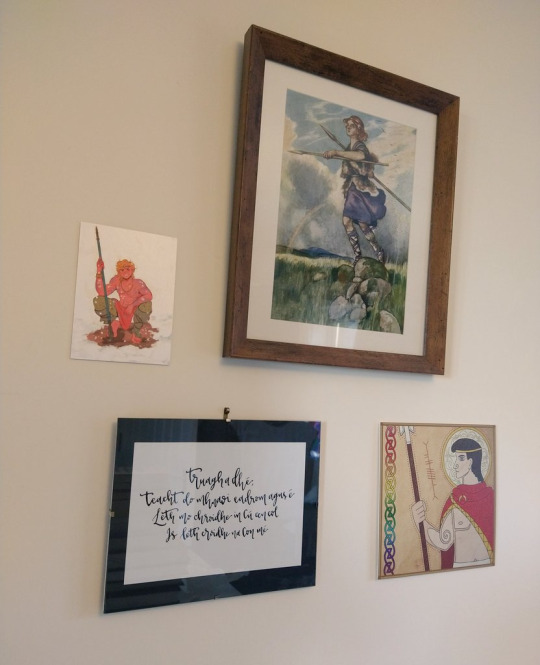
The latest addition to my Cú Chulainn wall is @amylouioc's goblinous little Cú Chulainn in the snow, who arrived today. I love him! It's a shame I lost my postcard of the spiky Cú Chulainn from the cover of A History of Ireland in 100 Words, though, because he looks a little small compared to the others and could do with another postcard-sized friend... Maybe I will be able to replace that lost card eventually.
Other art: Stephen Reid's "Cuchulainn to Emain Macha"; @forfeda-project's "Pride Cú", and a quote from the Stowe Táin that @ad-ciu gave me for Christmas a couple of years back.
16 notes
·
View notes
Note
Happy WBW! What is a common souvenir that someone would bring back for a friend if they'd just come back from vacation/holiday? (I'm thinking the equivalents of postcards, magnets, keychains, mugs, etc!)
Hey @writernopal, happy WBW!
I can't think of something for "Their Call for Home" now, because it sounds kinda weird to bring souvenirs from one place in this world. I vibe more with bringing something unique from the area, like certain handcrafted wares. Mer'Teval, where everything takes place, for example, is known for their gemstone jewelry and variety of enchanted amulets.
For "Rebellious Souls" it looks a bit different.
I still need to give those damn town names, but the city where it is set has a lion in its city crest. Little wooden shields with the crest are a favorite by visitors, along with the lion head pins. Another thing people like to show off, are theater and/or opera tickets because it is the capital city with the biggest theater and opera, so being able to see a play there is a big thing.
Keir's hometown is a sea town and known for their intricate patterns in anything crocheted or knitted, so people would buy scarf, mittens, even sweater from the locals with those patterns. (Think of the famous Aran patterns in Ireland.)
Màiren comes from the countryside, where vineyards grow. Actually, the only place in the whole country where grapes succesfully grow, therefore a bottle of wine from one of the smaller local wineries is a must when visiting the area.
4 notes
·
View notes